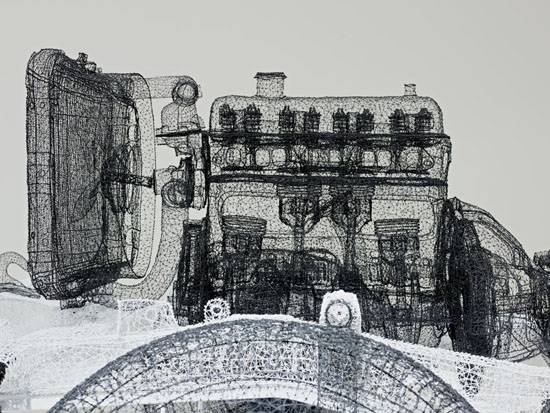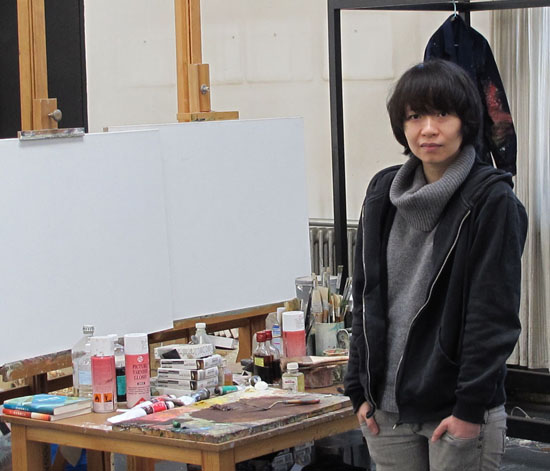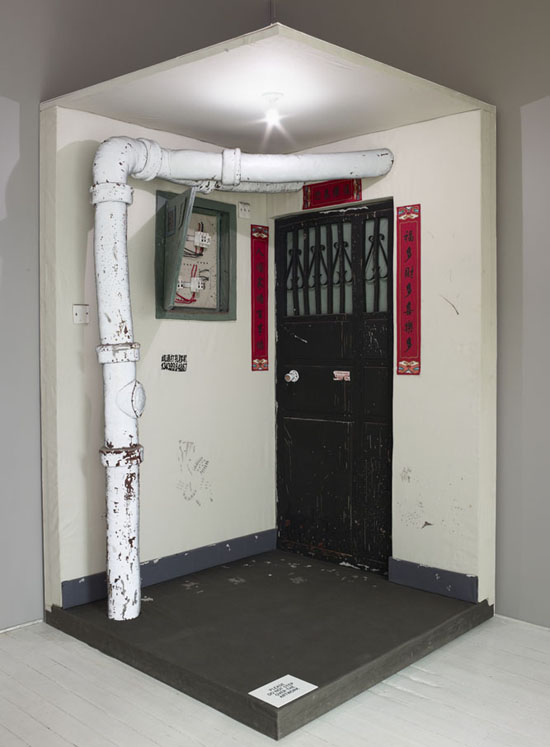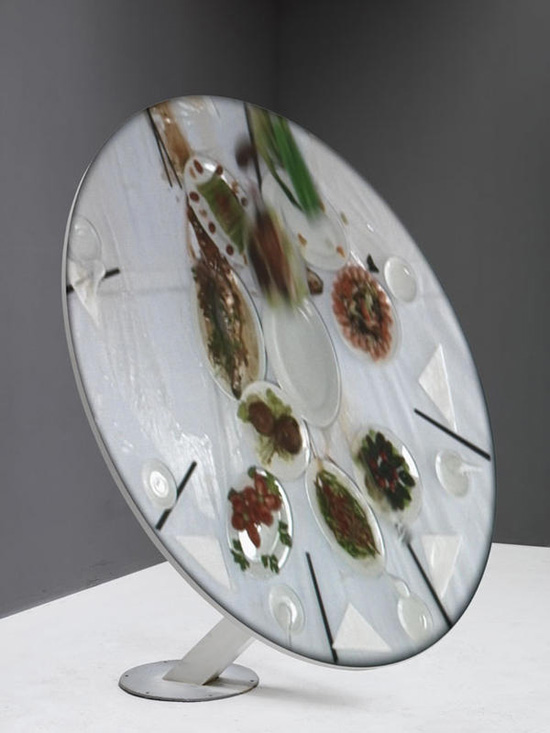Luise Guest takes a tour through White Rabbit’s latest hang…
The dictionary defines a ‘double take’ as ‘a delayed reaction indicating surprise’. And double happiness? Apart from its usual associations with Chinese weddings, it’s the experience of being able to see once again some favourite works from the White Rabbit collection of contemporary Chinese art in new contexts, rehung in interesting combinations, in their new show, ‘Double Take’.
Why ‘Double Take’? Firstly, it aptly describes the curatorial intention – to allow audiences to reconsider works which have been seen before, to see them anew, and to find new resonances within them. Secondly, all the works in this show have been cleverly chosen in order to repay the careful viewer with unexpected delight and often quite surprising revelations – the classic ‘double take’ of comic timing. The title is clever and so is the show.
Shi Jindian, Beijing Jeep’s Shadow, 2007, detail, steel wire, image reproduced courtesy of the artist and White Rabbit Gallery.
The works on the top level of the gallery certainly live up to this promise. Ai Weiwei’s porcelain sunflower seeds, with their multiple layers of meaning, can now be reconsidered following the artist’s incarceration, his elevation to a kind of dissident iconic status, and the release of the documentary Never Sorry. The choice of porcelain represents China’s export industry from imperial times: literally ‘china’. The sunflower seeds (especially when 100 million of them filled the Tate Modern Turbine Hall) can be seen to represent the masses, every seed individually hand painted, every seed different, yet all appearing on the surface to be identical, conforming to expectations. Mao of course was often represented as the sun, with the adoring masses turned to him like sunflowers. And sunflower seeds were the snack available to the proletariat during the Cultural Revolution – Ai Weiwei remembers his father, the banished poet Ai Qing, sharing them during his long exile in the countryside.
On the adjoining walls are two works which further illuminate some of the ideas in Ai’s work. Dai Hui’s I love Beijing’s Tiananmen Square is a fantastically detailed and complex pixelated panorama filled with characters from Chinese life and history – and from global popular culture. The ubiquitous ice cream sellers and purveyors of DVDs are here, as are the tanks entering the square – a politically potent image. Imagine the Beatles in their yellow submarine confronting imperial figures and PLA soldiers; Spiderman facing up to Cultural Revolution ballet dancers; or Dorothy and the Tin Man coming face to face with the famous image of the man holding his shopping bags confronting the tanks in 1989, represented in the style of early Mario Brothers computer games. The Chinese national television station, CCTV, fills the crania of rows of tiny people with neat piles of excrement. The work is at once charming, funny and transgressive. On the opposite wall, a new Pisan video work Cracking Sunflower Seeds shows a series of school children, represented in his characteristic comic book style as cartoon speech bubbles, attempting to get out the words, ‘Once upon a time, there was a man selling sunflower seeds….’ into a microphone. Each time, a cartoon hand yanks the frightened child off the screen. The last child only manages to get out a sigh, which sounds like ‘Ai’. In the next frame sunflower seeds spell out the character for the word ‘Ai’. A voice yells ‘Tamade! Damn it! Who sold us those fake sunflower seeds?!’ In a world where the words ‘Ai’, ‘Sunflower Seeds’ and ‘Fake’ (the name of Ai Weiwei’s studio) were all censored from Chinese social media site Weibo, this is darkly funny.
The main focus of attention, however, is an installation that literally causes viewers to do a ‘double take’. A fake media conference, in which fake models of TV cameramen and a microphone-wielding journalist interview the artist, who appears in the form of a video projected onto a white model. I watched people enter the space and then hang back, obviously uncertain for a minute about whether an actual press conference was taking place. Zhou Xiaohu was one of the first Chinese contemporary artists to experiment with combinations of sculpture and video, and in this work he continues his satirical examination of media control and the manipulation of public opinion. A Chinese acquaintance told me that she worked as a TV journalist in Beijing, until she could no longer stand the lies she was required to tell. ‘Even the weather report was a fake’, she said. Her comments inevitably sprang to mind on encountering this work – it speaks volumes about the ways in which lies and evasions become accepted as fact. These four works reveal the ways in which Chinese artists are peeling back the veils of official happy talk and revealing some uncomfortable truths, often at considerable personal risk.
Your experience of this exhibition will vary depending on whether you have encountered the works before in earlier White Rabbit shows. I was struck anew by the quality and diversity of the collection. One floor contains stunning paintings by Liang Yuanwei, who was selected for the last Venice Biennale. She has worked across many forms, including photography, painting and installation. These works are from a series of richly painted impasto canvases which simulate pieces of cloth, some with deliberately banal flower patterns, some with checks or dots. It’s a slightly satiric version of high modernist ‘all-over painting’, replacing the serious angst of abstraction with domestic textiles as sewn and worn by ordinary women. When I spoke with the artist in her Beijing studio last year she told me that like many Chinese artists of her generation she has been particularly influenced by Joseph Beuys, but she has also found inspiration in the life and work of the American sculptor Eva Hesse. From an unhappy period where she unwillingly studied in the Design Department at the Central Academy of Fine Arts because her father would not permit her to study Fine Arts, she finally managed to find her way as an artist, despite many obstacles along the way. She told me ruefully of ‘losing face’ as a postgraduate student by asking undergraduates to show her how to stretch a canvas. Liang is now heralded in the press as one of the best Chinese painters under thirty five, an accolade which she finds amusing.
On the opposite wall is her Salt Series: Little Clocks, a quiet work which packs quite a punch when you take time to consider its implications. A row of small shelves hold everyday objects – a pair of canvas shoes, a watch, a passport, a packet of cigarettes. A woman’s shirt, slightly crumpled, hangs on the wall. Tiny watch hands are attached to each object, almost invisible until you look closely. Is it about the way we waste time in all the mundane trivia of everyday life? All those seconds, minutes and hours spent on truly unimportant things. It is impossible to look at this work and not to contemplate one’s own finiteness – at least for a second or two.
Artist Liang Yuanwei in her Beijing studio, March 2011, photograph Luise Guest, reproduced with the permission of the artist.
In this quiet and reflective space, the sheer beauty of Zhang Chun Hong’s ‘Life Strands’, an 11 metre paper scroll with a beautifully detailed charcoal and graphite drawing of a long plait, is also suggestive of life cycles, of youth falling away. It is very seductive yet also surprisingly melancholy. Nearby, Liu Zhuoquan’s table of glass bottles painted on their inside surfaces with body parts, internal organs, and minutely detailed flora and fauna, presents a very different aspect of this artist’s practice than the large installation showing at the MCA in the Biennale of Sydney. These are small, delicate, visually compelling. They speak of the artist’s time in Tibet and his fascination with Buddhist practices, as well as his ability to merge an ancient tradition of ‘neihua’ (snuff bottle painting) with a very contemporary sensibility.
Gao Rong, Level 1/2, Unit 8, Building 5, Hua Jiadi, North Village (2010) fabric, thread, sponge, metal, image reproduced courtesy of the artist and White Rabbit Gallery.
A work which absolutely repays the ‘double take’ is Gao Rong’s simulacrum of the grungy entryway to her Beijing basement apartment, ‘Level 1/2, Unit 8, Building 5, Hua Jiadi, North Village’. It takes a little while to realise that every single aspect of this downmarket urban corner doorway, from the rust stains, peeling paint and dirty footprints on the wall, to the downpipes and electrical box, to the metal grille on the front door, are all meticulously stitched and sewn from fabric. Similarly her replica of a Beijing bus stop sign, with its timetable and scrawled phone numbers, takes an element of the utterly everyday and makes us see it with fresh eyes. This artist’s wonderful replica of her grandparents’ traditional house in Inner Mongolia has been one of the surprise hits of the Biennale at the Art Gallery of New South Wales. Wonderful though that is, the small scale and intimacy of the works at White Rabbit make them even more arresting. Shi Jindian’s crocheted structures – crocheted, ridiculously and wonderfully from steel wire – create ethereal shadow forms of powerful machines. And again with the possible double-coding: they are replicas of a Soviet copy of a BMW, and a US Army jeep. Tongue-in-cheek? Quite certainly. Wang Gongxin has created a work projected onto a tilted round banqueting table, in which the lavish food and liquor is spilled and destroyed. Bottles and glasses are knocked over and plates fall from the table. But they fall upwards, in slow motion, defying the laws of gravity and subverting our expectations.
A delayed reaction indicating surprise? At White Rabbit, most definitely.
Wang Gongxin, Dinner Table, 2006, video installation, audio, 5:00. Image reproduced courtesy of the artist and White Rabbit Gallery.




